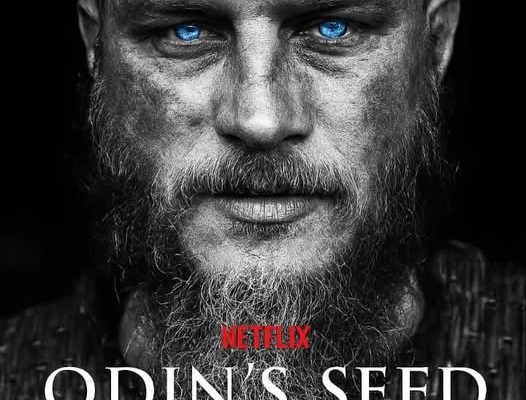The new Netflix release, Odin’s Seed: A Myth Forged in Blood, Destiny, and Immortality, has quickly captured the attention of audiences across the globe, plunging viewers into a world where myth and reality bleed into one another with staggering intensity. It is not just a fantasy epic—it is a meditation on legacy, sacrifice, and the cruel weight of destiny, told through the lens of Norse mythology reimagined for a modern audience. The film manages to be both intimate and colossal, grounding its larger-than-life spectacle in human emotion while never losing the grandeur expected from a tale that draws from the well of Odin himself.
From its opening sequence, Odin’s Seed makes it clear that it is not content to be another generic entry in the saturated market of mythological adaptations. The film begins with a haunting prologue, a voice whispering through darkness about the creation of man not as an act of love, but as a gamble, a test designed by gods who themselves feared mortality more than any mortal ever could. This philosophical opening lays the groundwork for a narrative that is not only about battles and gods but about questions that every viewer, regardless of their familiarity with Norse sagas, can feel pressing against their own existence: What does it mean to live under the shadow of fate? What would one sacrifice to defy the inevitability of death?
The story centers on Eirik, a young warrior unknowingly carrying the divine essence of Odin’s own bloodline, a fragment of immortality hidden within him since birth. His existence is not an accident, but a design forged in secrecy, a seed planted by Odin himself before his fall, intended to sprout in an era when gods are forgotten, and mankind teeters on the brink of annihilation. As Eirik grows, the truth of his origin begins to manifest—not in blessings of ease, but in torment, visions, and a weight of expectation that crushes his spirit before he even fully understands who he is. The film takes great care to portray Eirik not as a flawless hero but as a fractured soul torn between the desire for an ordinary life and the relentless pull of destiny.
Netflix’s adaptation thrives in this duality. It juxtaposes breathtaking sequences of battles dripping with cinematic spectacle—fire-lit raids on coastal villages, monstrous beings tearing through armies, and celestial storms that fracture the sky—with quiet, painful moments where Eirik questions whether immortality is a gift or a curse. His interactions with his mortal companions underline the tragedy of his existence: while they age, bleed, and love without the weight of eternity, he must confront the truth that his very presence warps the natural order of life.
The antagonist, however, elevates the narrative beyond the typical hero’s journey. In Odin’s Seed, death itself is personified through Hel, the goddess of the underworld, reimagined not as a grotesque caricature but as a chillingly beautiful, calculating force who views Eirik as a violation of balance. For Hel, Odin’s seed represents blasphemy—a loophole in the divine cycle that threatens to undo the very fabric of mortality. Her pursuit of Eirik is not born of malice alone but of conviction, a belief that the natural laws must remain unbroken, even if it means obliterating the last remnant of Odin’s legacy. The philosophical tension between Eirik’s struggle for freedom from fate and Hel’s insistence on preserving cosmic order fuels the drama as much as the physical confrontations.
One of the film’s greatest strengths is its ability to draw from Norse myth without being enslaved by it. Viewers familiar with the Eddas and sagas will recognize threads—references to Yggdrasil, the World Tree; glimpses of ravens that guide Eirik in moments of doubt; runes etched into weapons that hum with ancient power. Yet the narrative reshapes these elements, weaving them into a story that feels accessible and fresh. The screenplay refuses to lean too heavily on exposition, instead trusting audiences to absorb the mythology through atmosphere, symbols, and the unspoken weight carried by the characters. The result is a world that feels both authentically ancient and vividly alive, not a museum piece but a living myth unfolding on screen.
Visually, the film is nothing short of stunning. The cinematography leans into contrasts—the icy desolation of Nordic landscapes against the fiery blaze of raiding longships, the quiet glow of a hearth where mortals share fragile joy against the overwhelming darkness of Hel’s underworld. The color palette frequently shifts to mirror Eirik’s internal conflict: golden hues when he clings to fleeting moments of humanity, cold blues when destiny suffocates him, and deep crimson during the most violent sacrifices. Netflix’s investment in production quality pays off here; Odin’s Seed rivals, and in some ways surpasses, the spectacle of big-budget theatrical releases. Every frame feels deliberate, painterly, and resonant with symbolism.
But spectacle alone does not make a film endure. What truly sets Odin’s Seed apart is its emotional core. At its heart, this is not a story about gods but about human beings grappling with mortality and meaning. Eirik’s journey is echoed in the lives of those around him. His mother, who raised him without ever revealing the truth of his bloodline, represents the human cost of secrets kept in the name of destiny. His closest companion, Astrid, a shield-maiden who fights not for glory but for survival, provides the grounding presence of mortal love—fierce, finite, and all the more precious for its impermanence. Their relationship is tender yet tragic, haunted by the fact that Eirik will outlive her, no matter how much he longs to share her fragile humanity.
The screenplay cleverly ties this theme to the broader conflict. While Hel hunts Eirik to restore balance, Eirik himself is torn between embracing the godlike power within him and rejecting it in the hope of living, even briefly, as a man. This tension crescendos in the film’s third act, where he must make an impossible choice: to unleash his immortal essence and save his people from annihilation, knowing it will bind him eternally to Odin’s will, or to refuse destiny and allow mortality—his own and others’—to claim its natural course. The climax is both visually breathtaking and emotionally devastating, leaving audiences questioning what they themselves would choose if given the chance to defy death at the cost of true life.
The performances anchor the film’s mythic weight in human reality. The actor portraying Eirik delivers a nuanced performance, balancing vulnerability with quiet strength, ensuring he never feels like a cliché of the chosen one. Hel’s actress commands every scene with icy elegance, making her as compelling as she is terrifying. Even the supporting cast is given enough depth to matter; their deaths, their hopes, their fleeting joys are not brushed aside but woven into the tapestry of Eirik’s journey, reminding viewers that immortality is meaningless without the mortal lives that give it contrast.
Critical reception has already noted the boldness of the film’s ending, which refuses to provide a neatly tied resolution. Instead, it leaves viewers in the unsettling space between triumph and tragedy, where myth often dwells. Some may find this ambiguity frustrating, but it is precisely what gives Odin’s Seed its staying power. Myths, after all, are not meant to comfort; they are meant to unsettle, to provoke, to force reflection on truths too vast and uncomfortable to confront in everyday life. Netflix has dared to craft a film that honors this ancient function of storytelling rather than diluting it into mere entertainment.
The release of Odin’s Seed also speaks to Netflix’s ongoing strategy of investing in original epics that can rival theatrical blockbusters. But beyond corporate ambition, the film taps into a cultural hunger for stories that blend spectacle with depth. In an era where many fantasy narratives are reduced to formula, this film dares to embrace myth not as escapism but as a mirror. It reminds us that the old stories—the ones about gods, blood, sacrifice, and fate—are not relics but living frameworks through which we can still understand ourselves.
In the days since its release, discussions around the film have erupted online, with fans dissecting its symbolism, debating Eirik’s final decision, and speculating whether Netflix will expand this world into a larger saga. Yet whether sequels arrive or not, Odin’s Seed stands firmly as a complete tale in itself, a myth forged not only in blood, destiny, and immortality but also in the fragile, fleeting beauty of what it means to be human.



